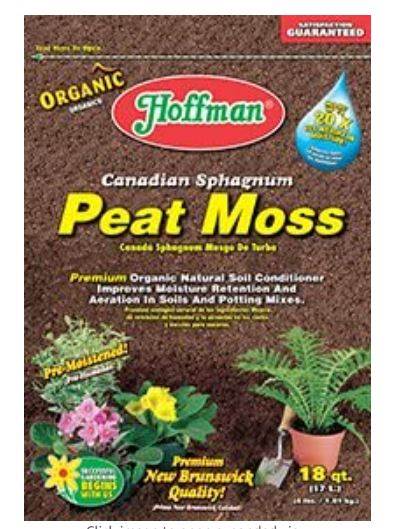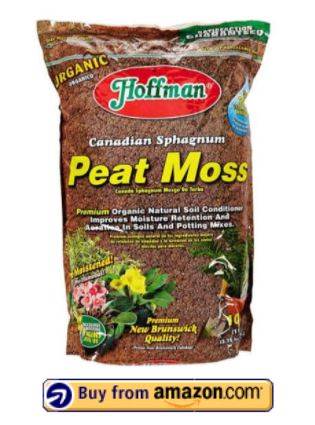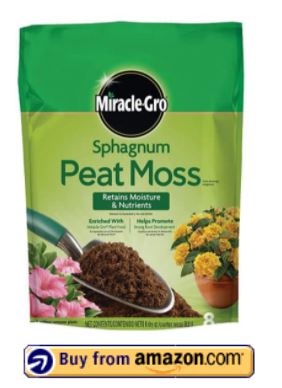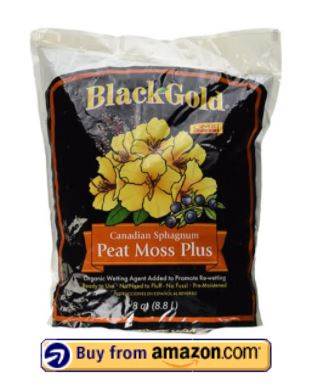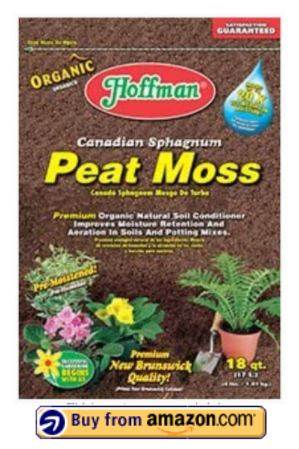Peat Moss
What is Peat Moss?
Peat moss is dead fibre-rich material that forms when sphagnum moss plants and other living substances partially decompose in peat bogs. Over several millennia, sphagnum moss plant materials submerged in bogs have decayed to create a soil type called “peat.” There is a big difference between a gardener’s backyard compost and the peat moss. The Peat Moss mainly consists of moss, and the putrefaction occurs in water-saturated bogs in the absence of air, which slows the decomposition rate. Peat formation is an ongoing process that takes thousands of years, and wetlands accumulate peat at an annual rate of 0.5-1.0 mm. Accumulation of plant material is higher in places where ambient temperature supports optimum plant growth. Simultaneously, the rainfall level, landscape’s specific topography, and reduced transpiration enhance waterlogging, limiting aerobic break down of the plant material. The conditions are mainly found in the northern hemisphere. The formation process is prolonged; hence, peat moss is not categorized as a renewable resource, and this is one of the major concerns that has hindered the use of peat moss.
Peat moss is mainly found in the northern hemisphere’s bogs and wetlands, covering about 2 per cent of the earth’s surface. Over 65 per cent of the wetlands globally are peat, and almost 10 per cent of the peat has been utilized for agricultural purposes. The world’s highest peat moss suppliers are Russia and Canada, supplying about two-thirds and one-quarter, respectively. In Canada, peat is harvested or mined following an environmental impact assessment study, upholding conservation, and bog rehabilitation strategies. The peat moss used in America mostly comes from Canada, where only 0.02 per cent is harvested annually.
Below are some of the best Peat Moss commonly used around the world:
Table of Contents
1. Hoffman 15503 Canadian Sphagnum Peat Moss, 10 Quarts
The Hoffman 15503 is one of the commonly used sphagnum peat moss variety in the market. It was harvested and prepared in Canadian from the rich sphagnum peat moss bogs. The peat moss type is a premium and high-quality grade for horticultural use. This sphagnum peat moss has a higher organic rating of 99.8 percent, ideal for providing ideal growing conditions for vegetables and fruits. The higher organic matter content means Hoffman 15503 Canadian Sphagnum Peat Moss can enhance the water holding capacity of garden soil when mixed appropriately. Also, it encourages the soil to retain and slowly release nutrients when needed by plants.
This peat moss package comes in the measurement of 2-inch by 9-inch by 14-inch in length, width, and height, respectively. The peat moss package contains 10 quarts of sphagnum organic materials, which is about 9.5 kilograms; it is relatively lightweight.
When gardeners desire a customized soilless potting mix, the Canadian sphagnum peat moss (premium grade) can be mixed with perlite and vermiculite to provide aeration and conducive conditions in the root zone of the potted plant.
Suppose you wish to provide your gardening soil with an ideal dose of natural organic soil conditioning material. In that case, the Hoffman 15503 coarse sphagnum peat moss is the best choice to enhance your soil’s water retention capacity nutrient-viably while reducing soil compaction. You can purchase the product on amazon to ensure your plants get the best growing conditions.
2. Miracle-Gro Sphagnum Peat Moss, 8 Quart
This sphagnum peat moss is by the Miracle-Gro company. The product is one of the best and commonly used soil conditioning substances by gardeners worldwide, with a high rating of 4.58 out of 5. Also, the product is enriched with plant nutrients from Miracle-Gro.
The Miracle-Gro Sphagnum Peat Moss is an ideal ingredient to lighten starting or seeding mix and potting soil since its coarse and fibrous texture helps create spaces for aeration between soil particles. Lightening soil mixes also means the peat moss can effectively reduce soil compaction. By reducing soil compaction, the Miracle-Gro Peat Moss also enhances effective and robust plant’s root development. The peat moss material offers a unique water-retention capability; thus, plants do not require frequent watering.
For acid-loving plants, it is recommended that gardeners should add equal units of Miracle-Gro Sphagnum Peat Moss and potting mixture when creating a medium for potted plants. For a seed starting mix, blend equal parts of the peat moss and Miracle-Gro perlite. You can also improve your gardening soil by incorporating the Miracle-Gro Sphagnum Peat Moss with the garden soil in a ratio of 1:1. However, it is advisable to read and follow instructions on the product label before use. It is ideal for usage both in a container and in-ground soils.
If you want to enhance your potting and starting mixes to retain more moisture and nutrients for healthy plant growth, the Miracle-Gro Sphagnum Peat Moss is available for purchase on amazon either one pack or two packs, each containing 8-quarts.
3. Sun-Gro Horticulture Black Gold Peat Moss Plus
The product is another useful additive gardener can use to enhance their plants’ growth. The Sun Gro Horticulture Black Gold Peat Moss is purely Canadian sphagnum peat manufactured by BFG Supply and has a lightweight of 1 pound. The product contains 100 percent natural ingredients, and the main ingredient is Canadian sphagnum peat moss. It is one of the best natural, organic soil conditioning products in the market.
The Sun Gro Horticulture Black Gold Peat Moss is an appropriate ingredient for adding into garden soil. It provides better plant growing conditions by improving water holding capacity and aeration while preventing waterlogging. The peat moss material is immensely enriched with ingredients to provide better conditions for acid-loving plants; the sphagnum peat moss can reduce the pH of alkaline mixes or soils. The Sun Gro Horticulture Black Gold Peat Moss is recommended for gardeners who want to do soil amendment to enhance soil water retention and aeration at the plant’s root zone while reducing soil compaction for healthy root development. The peat moss material can be mixed with available garden soil to develop a custom and desired mix.
The Sun Gro Horticulture Black Gold Peat Moss is versatile enough and can be used in lawn and landscape, raised beds, and soil amendments. One can also mix the peat moss material in a potting component to give an ideal condition for potted plants.
Make your plants thrive in better growing conditions under less frequent watering by obtaining the 1.0 lb pack from amazon for 13.69 dollars, exclusive of the shipping fee.
4. Hoffman Canadian Sphagnum Peat Moss - 18 Quart
Another useful peat moss material made in the USA by Good Earth Organics Corp offers many benefits to gardeners. The product is widespread and one of the best gardeners love across the world, and the package comes in dimensions of 1×1×1 inch with a light weight of 8.68 pounds. This premium-grade sphagnum peat moss has an ideal soil amendment; it comes in Canadian sphagnum peat’s grower grade quality. When appropriately mixed with soil, the Hoffman Canadian Sphagnum Peat Moss – 18 Quart enhances the soil’s water-holding capacity and nutrient conservativeness; it helps in water and nutrient retention for many years once applied.
The Hoffman Canadian Sphagnum Peat Moss – 18 Quart is 100 percent organic matter. The less-compact and fibrous peat moss material help to aerate soils and loosen compacted or heavy clay soils. The high organic matter content in the peat material also binds loose sandy soils; thus, allowing them to retain moisture and give conditions necessary for plant growth. Aeration and loosening of compacted soils, especially around the plants’ root zones, help stimulate vigorous root development.
You can blend the Hoffman Canadian Sphagnum Peat Moss – 18 Quart material with perlite and vermiculite to obtain a custom soilless potting mix. The peat moss material is available at an affordable price on amazon for 28.29 dollars.
In conclusion, Peat Moss is a vital soil additive despite the environmental concerns that have created a debate around the material. The organic content in sphagnum peat moss is essential in providing ideal conditions for plants to thrive. Peat Moss is very beneficial for preparing gardening soils from water and nutrient retention capacity to soil aeration to the reduction of soil compaction and healthy root development. Its slower decomposition in the absence of air makes it useful for many years once added to the soil. But because peat moss acidifies the soil, the application of lime afterward is crucial to maintain conducive growing conditions.
Peat Moss Uses
Peat moss is a multipurpose material used for gardening, and gardeners can use it for many different landscaping works. Over recent decades, there have been concerns on whether Peat Moss mining is sustainable or not; therefore, it is probably ideal to ensure prudent use of the material.
Potting soil: Peat moss is usually used as an ingredient for lightening potting soil to allow the soil to retain moisture effectively; therefore, potted plants will have nutrients that are essential for healthy growth. It keeps about 20 times its weight in moisture and allows slower water release. Peat moss is lightweight and fluffy; thus, allowing adequate air for the plant’s roots in the soil. The peat moss surrounds and anchors the plants’ roots to make plants sturdy against the wind.
Transplanting plants: Plants are known to add a highlighting texture to a home yard without maintenance. However, transplanting large plants is most challenging, especially when the soil where you want to transplant the tree does not enhance growing conditions. Hence, peat moss is useful when transplanting trees and shrubs; it binds sandy soil and loosens heavy clay soil, thus aerating them. Also, peat moss prevents soils from hardening while adding organic matter. The peat moss absorbs and retains water; hence, trees and shrubs get adequate moisture after re-planting.
Fortifying lawn: For those who want a lush, healthy lawn, peat moss is the best soil conditioner to enhance the healthy growth of grass. Like in potted and transplanted plants, peat moss improves aeration in the root zones and retains conducive moisture and nutrient level for your lawn.
Compositing: Compost pile is handy for gardeners as it provides a good source of eco-friendly manure for your plants and lawn from decomposing organic material. Food scraps, grass clippings, and dead leaves are useful compost material, but it is sufficient to add peat moss to the mixture. Peat is rich in nutrients but decomposes at a slower rate than compost material, thus ensuring soil-nutrient retention for longer by balancing out fast-decomposing organic material.
How to Utilize Peat Moss in the Garden?
Although there are environmental concerns relating to peat moss’s carbon emission, the material still has considerable benefits to garden soil. Gardeners should amend garden soil by using one-third peat moss (2 units of soil to one part of peat moss material) and evenly mix the material 12 inches deep into the soil. In the garden, peat moss moderate extremes of soil moisture, dryness, and wetness. The peat moss material has a lower pH, which is necessary for acid-loving plants, including fruits and vegetables. Peat moss is well known for its horticultural uses to offer better soil aeration, sufficient soil nutrient holding, and helping in soil moisture retention without water-logging. Peat moss is also a useful component of potting mixes without soil, which can be added to perennial or woody plants’ holes during planting. The effective way to utilize peat moss sustainably is by reversing it for applications if there is no alternative and use it on a small-scale basis. If you add peat moss to a whole garden or bed, it is advisable to conduct a soil test afterward; you will need to apply lime since peat moss acidifies the soil due to its lower pH, and compost can work well to neutralize soil acidity.
Benefits of Mixing Peat Moss and the Soil
Peat moss provides many advantages and benefits to garden soil that make plants thrive. The material has several essential features gardeners usually want their garden soils to possess. First, peat moss is highly absorbent, and it helps make garden soil to retain adequate water for plant growth. Second, peat moss offers a sterile medium, which is essential for growing plants. When added to garden soil, peat moss provides an ideal starting mix since it does not contain chemicals or weed seeds; it is suitable for vulnerable plants that need a lot of care. Third, peat moss has acidic pH, and it provides an acidic medium for acid-loving plants like blueberries and camellias when added into the garden soil. Lastly, peat moss material is fibrous and not compact, like other organic material. When soil compacts, it becomes less critical, and peat moss comes in handy to prevent soil compaction from occurring. Soil compaction hinders water absorption and offers a low medium for plant growth. A single application of peat moss into garden soil can prevent soil compaction for several years. Also, it binds sandy soil together, thus improving its water retention ability.
Peat moss is an eco-friendly organic soil conditioner capable of regulating moisture and air around plants’ root region for optimum growth conditions. Also, an appropriate blending of peat moss with perlite and vermiculite helps the soil to retain more moisture and promote aeration over a long period.
Before Adding Peat Moss to the Soil
Peat moss is a useful material that gardeners should appreciate. It is an ideal ingredient to garden soil to provide conducive growing conditions. However, there are practical considerations gardeners should make before adding peat moss to the ground. The garden soil needs to be prepared so that it mixes well with the peat moss material. If you qualify and efficiently amend the soil with peat moss, the soil conditions can remain conducive for several years. Dig and loosen the garden section’s ground to add peat moss for the effective incorporation of the material. Measure and mix 1 part of peat moss to 2 pieces of the garden soil. Test the soil pH to ascertain if you will need to add lime resources (decomposing compost material) and to get the right rationing to prevent leaching.
Frequently Asked Questions (FAQs) and Answers:
Question: Is there a difference between sphagnum peat moss and peat moss?
Answer: No, peat moss and sphagnum peat moss are the same things. However, peat and peat moss are different.
Question: Does Peat Moss help lower pH of garden soil?
Answer: Yes, it does lower soil pH. Peat Moss is acidic, and it should lower the pH a bit depending on the concentration and rationing used during application.
Question: Should I apply Peat Moss as a top layer or mix with soil?
Answer: The primary purpose of using soil in gardening is to better the soil conditions for healthy plant growth. Most of the peat moss products available in the market work better if evenly mixed with soil. You can dig 12-inch deep and mix the peat moss with soil, evenly incorporate it into the ground by raking.
Question: Is Peat Moss ideal for growing Venus flytrap?
Answer: No. Most peat moss products have fertilizer, and fertilizer contents are harmful to carnivorous plants. Venus flytrap requires a neutral mix to thrive.

